2006 GMC SIERRA 1500 ECU
[x] Cancel search: ECUPage 501 of 600

Tire Chains
{CAUTION:
If your vehicle has dual wheels or P265/75R16,
LT265/75R16, P265/70R17 or P275/55R20 size
tires, do not use tire chains. They can damage
your vehicle because there is not enough
clearance. Tire chains used on a vehicle
without the proper amount of clearance can
cause damage to the brakes, suspension or
other vehicle parts. The area damaged by the
tire chains could cause you to lose control of
your vehicle and you or others may be injured
in a crash.
Use another type of traction device only if its
manufacturer recommends it for use on your
vehicle and tire size combination and road
conditions. Follow that manufacturer’s
instructions. To help avoid damage to your
vehicle, drive slowly, readjust or remove the
device if it is contacting your vehicle, and do
not spin your vehicle’s wheels.
If you do �nd traction devices that will �t,
install them on the rear tires.Notice:If your vehicle does not have dual wheels
and is equipped with a tire size other than
P265/75R16, LT265/75R16, P265/70R17 or
P275/55R20, use tire chains only where legal and
only when you must. Use chains that are the proper
size for your tires. Install them on the tires of the
rear axle. Don’t use chains on the tires of the front
axle. Tighten them as tightly as possible with
the ends securely fastened. Drive slowly and follow
the chain manufacturer’s instructions. If you can
hear the chains contacting your vehicle, stop
and retighten them. If the contact continues, slow
down until it stops. Driving too fast or spinning the
wheels with chains on will damage your vehicle.
5-89
Page 512 of 600
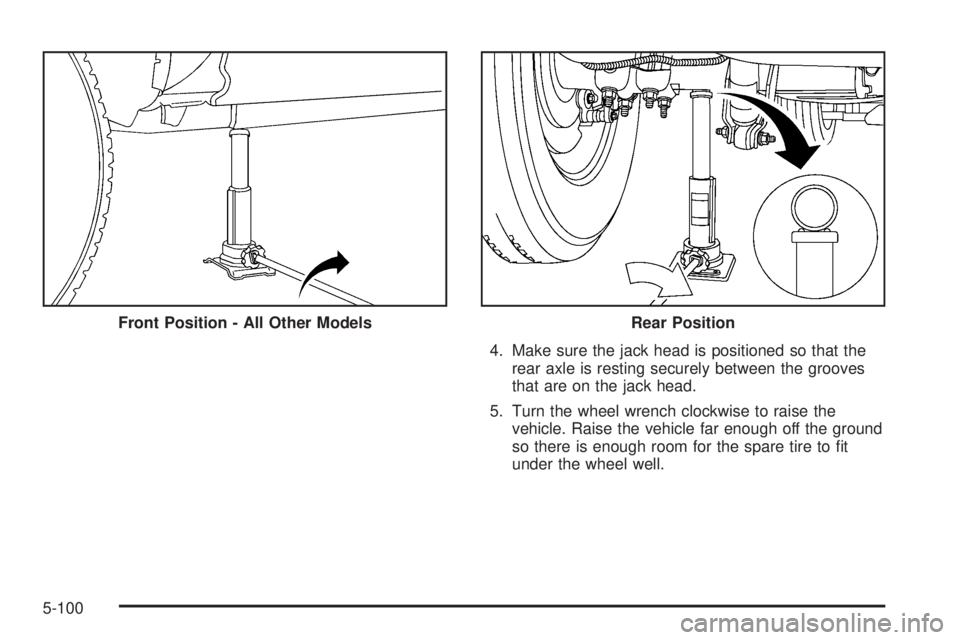
4. Make sure the jack head is positioned so that the
rear axle is resting securely between the grooves
that are on the jack head.
5. Turn the wheel wrench clockwise to raise the
vehicle. Raise the vehicle far enough off the ground
so there is enough room for the spare tire to �t
under the wheel well. Front Position - All Other Models
Rear Position
5-100
Page 518 of 600
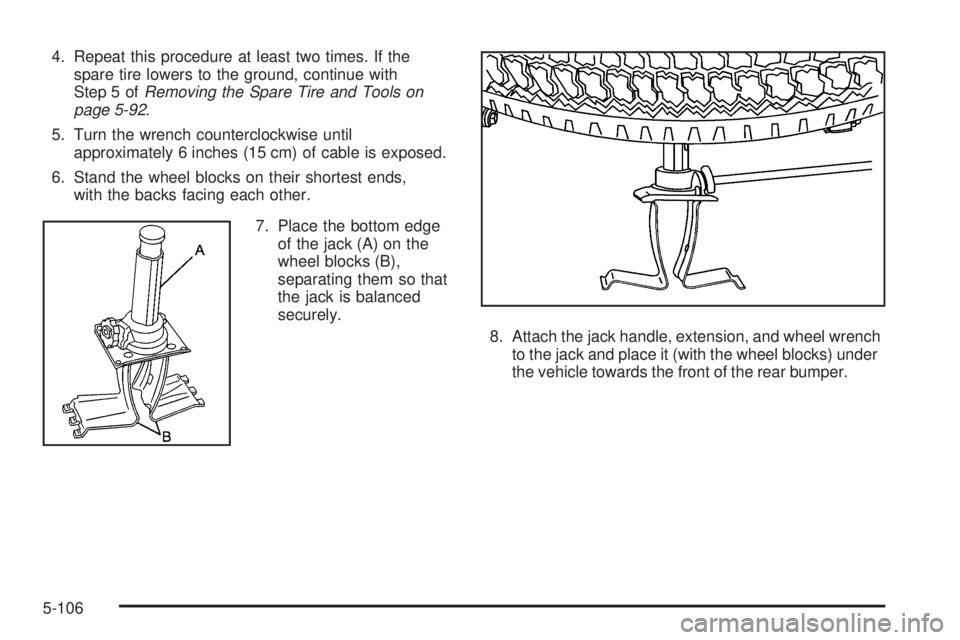
4. Repeat this procedure at least two times. If the
spare tire lowers to the ground, continue with
Step 5 ofRemoving the Spare Tire and Tools on
page 5-92.
5. Turn the wrench counterclockwise until
approximately 6 inches (15 cm) of cable is exposed.
6. Stand the wheel blocks on their shortest ends,
with the backs facing each other.
7. Place the bottom edge
of the jack (A) on the
wheel blocks (B),
separating them so that
the jack is balanced
securely.
8. Attach the jack handle, extension, and wheel wrench
to the jack and place it (with the wheel blocks) under
the vehicle towards the front of the rear bumper.
5-106
Page 522 of 600
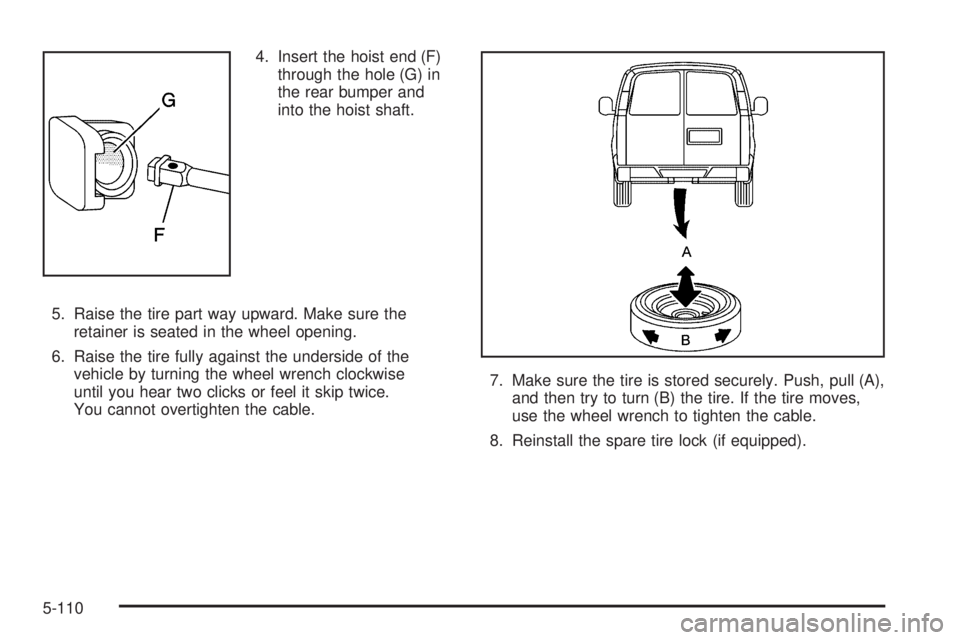
4. Insert the hoist end (F)
through the hole (G) in
the rear bumper and
into the hoist shaft.
5. Raise the tire part way upward. Make sure the
retainer is seated in the wheel opening.
6. Raise the tire fully against the underside of the
vehicle by turning the wheel wrench clockwise
until you hear two clicks or feel it skip twice.
You cannot overtighten the cable.7. Make sure the tire is stored securely. Push, pull (A),
and then try to turn (B) the tire. If the tire moves,
use the wheel wrench to tighten the cable.
8. Reinstall the spare tire lock (if equipped).
5-110
Page 560 of 600

At Least Once a Month
Tire In�ation Check
Visually inspect your vehicle’s tires and make sure they
are in�ated to the correct pressures. Do not forget to
check the spare tire. SeeTires on page 5-72for further
details. Check to make sure the spare tire is stored
securely. SeeChanging a Flat Tire on page 5-91.
Tire Wear Inspection
Tire rotation may be required for high mileage highway
drivers prior to the Engine Oil Life System service
noti�cation. Check the tires for wear and, if necessary,
rotate the tires. SeeTire Inspection and Rotation on
page 5-81.
At Least Once a Year
Starter Switch Check
{CAUTION:
When you are doing this inspection, the
vehicle could move suddenly. If the vehicle
moves, you or others could be injured.
1. Before you start, be sure you have enough room
around the vehicle.
2. Firmly apply both the parking brake and the regular
brake. SeeParking Brake on page 2-52.
Do not use the accelerator pedal, and be ready to
turn off the engine immediately if it starts.
3. Try to start the engine in each gear. The vehicle
should start only in PARK (P) or NEUTRAL (N). If
the vehicle starts in any other position, contact your
GM Goodwrench
®dealer for service.
6-12
Page 577 of 600
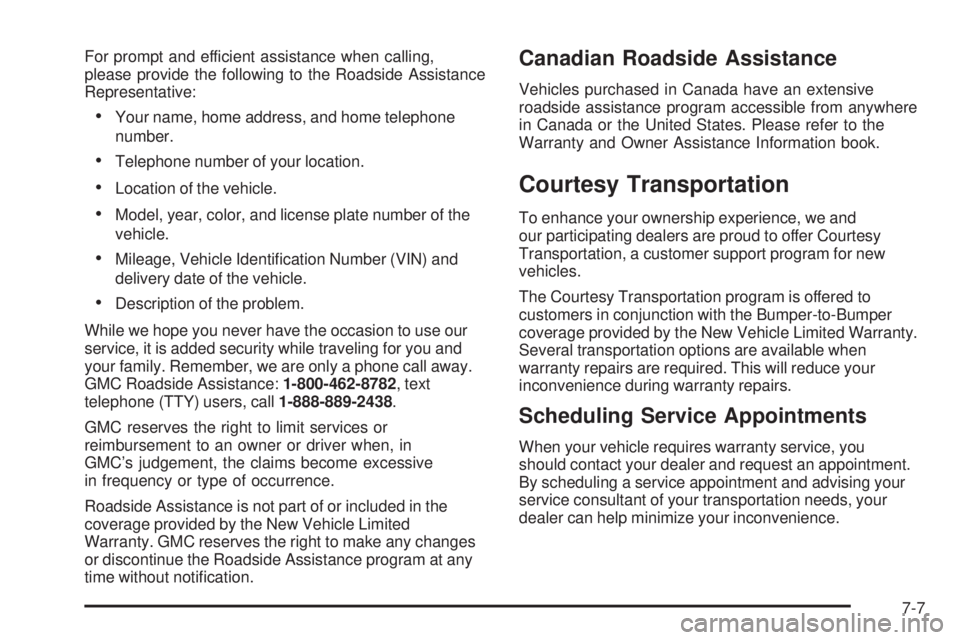
For prompt and efficient assistance when calling,
please provide the following to the Roadside Assistance
Representative:
Your name, home address, and home telephone
number.
Telephone number of your location.
Location of the vehicle.
Model, year, color, and license plate number of the
vehicle.
Mileage, Vehicle Identi�cation Number (VIN) and
delivery date of the vehicle.
Description of the problem.
While we hope you never have the occasion to use our
service, it is added security while traveling for you and
your family. Remember, we are only a phone call away.
GMC Roadside Assistance:1-800-462-8782, text
telephone (TTY) users, call1-888-889-2438.
GMC reserves the right to limit services or
reimbursement to an owner or driver when, in
GMC’s judgement, the claims become excessive
in frequency or type of occurrence.
Roadside Assistance is not part of or included in the
coverage provided by the New Vehicle Limited
Warranty. GMC reserves the right to make any changes
or discontinue the Roadside Assistance program at any
time without noti�cation.
Canadian Roadside Assistance
Vehicles purchased in Canada have an extensive
roadside assistance program accessible from anywhere
in Canada or the United States. Please refer to the
Warranty and Owner Assistance Information book.
Courtesy Transportation
To enhance your ownership experience, we and
our participating dealers are proud to offer Courtesy
Transportation, a customer support program for new
vehicles.
The Courtesy Transportation program is offered to
customers in conjunction with the Bumper-to-Bumper
coverage provided by the New Vehicle Limited Warranty.
Several transportation options are available when
warranty repairs are required. This will reduce your
inconvenience during warranty repairs.
Scheduling Service Appointments
When your vehicle requires warranty service, you
should contact your dealer and request an appointment.
By scheduling a service appointment and advising your
service consultant of your transportation needs, your
dealer can help minimize your inconvenience.
7-7
Page 589 of 600
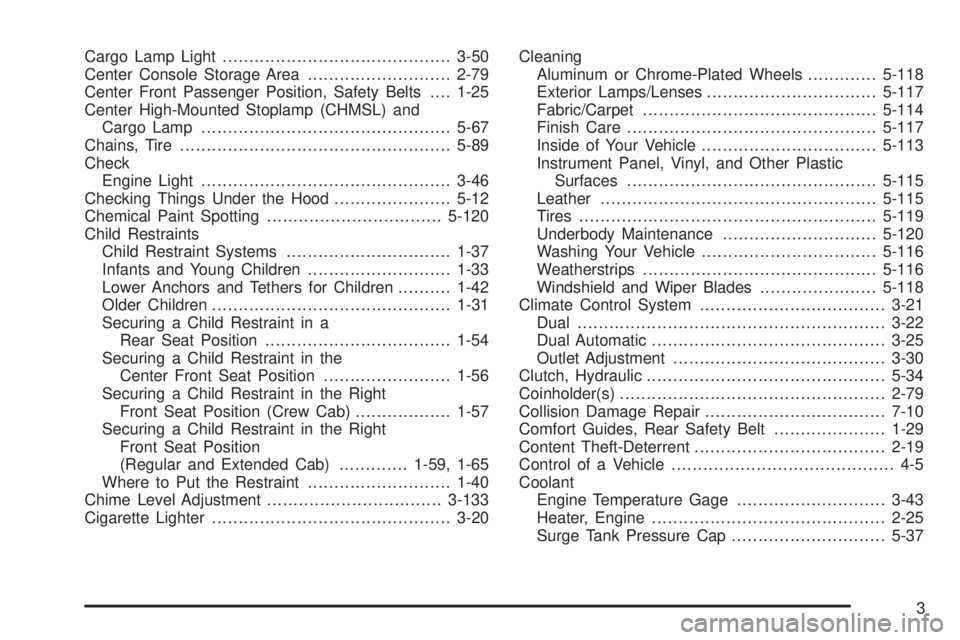
Cargo Lamp Light...........................................3-50
Center Console Storage Area...........................2-79
Center Front Passenger Position, Safety Belts....1-25
Center High-Mounted Stoplamp (CHMSL) and
Cargo Lamp...............................................5-67
Chains, Tire...................................................5-89
Check
Engine Light...............................................3-46
Checking Things Under the Hood......................5-12
Chemical Paint Spotting.................................5-120
Child Restraints
Child Restraint Systems...............................1-37
Infants and Young Children...........................1-33
Lower Anchors and Tethers for Children..........1-42
Older Children.............................................1-31
Securing a Child Restraint in a
Rear Seat Position...................................1-54
Securing a Child Restraint in the
Center Front Seat Position........................1-56
Securing a Child Restraint in the Right
Front Seat Position (Crew Cab)..................1-57
Securing a Child Restraint in the Right
Front Seat Position
(Regular and Extended Cab).............1-59, 1-65
Where to Put the Restraint...........................1-40
Chime Level Adjustment.................................3-133
Cigarette Lighter.............................................3-20Cleaning
Aluminum or Chrome-Plated Wheels.............5-118
Exterior Lamps/Lenses................................5-117
Fabric/Carpet............................................5-114
Finish Care...............................................5-117
Inside of Your Vehicle.................................5-113
Instrument Panel, Vinyl, and Other Plastic
Surfaces...............................................5-115
Leather....................................................5-115
Tires........................................................5-119
Underbody Maintenance.............................5-120
Washing Your Vehicle.................................5-116
Weatherstrips............................................5-116
Windshield and Wiper Blades......................5-118
Climate Control System...................................3-21
Dual..........................................................3-22
Dual Automatic............................................3-25
Outlet Adjustment........................................3-30
Clutch, Hydraulic.............................................5-34
Coinholder(s)..................................................2-79
Collision Damage Repair..................................7-10
Comfort Guides, Rear Safety Belt.....................1-29
Content Theft-Deterrent....................................2-19
Control of a Vehicle.......................................... 4-5
Coolant
Engine Temperature Gage............................3-43
Heater, Engine............................................2-25
Surge Tank Pressure Cap.............................5-37
3
Page 590 of 600
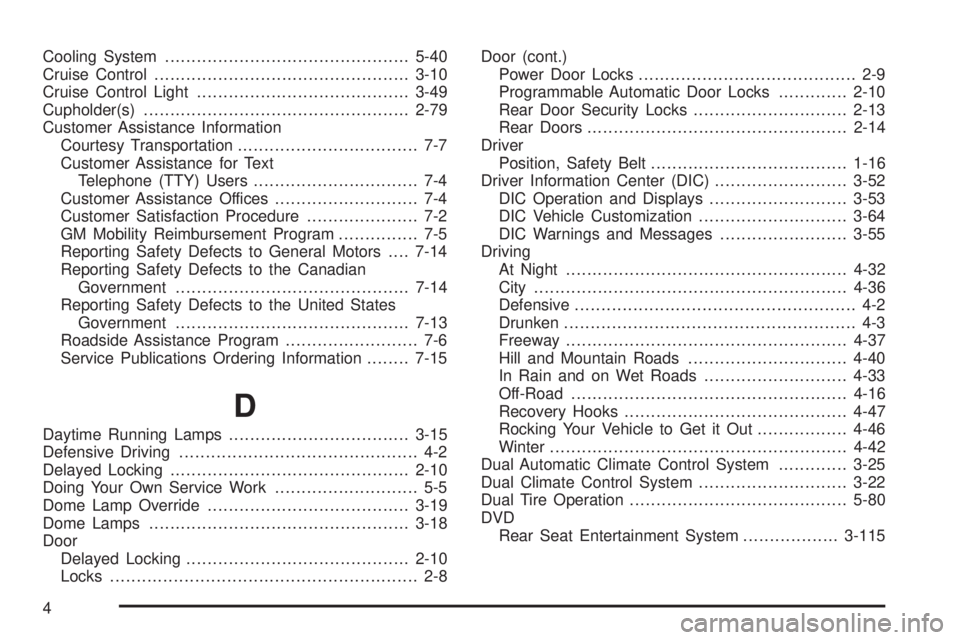
Cooling System..............................................5-40
Cruise Control................................................3-10
Cruise Control Light........................................3-49
Cupholder(s)..................................................2-79
Customer Assistance Information
Courtesy Transportation.................................. 7-7
Customer Assistance for Text
Telephone (TTY) Users............................... 7-4
Customer Assistance Offices........................... 7-4
Customer Satisfaction Procedure..................... 7-2
GM Mobility Reimbursement Program............... 7-5
Reporting Safety Defects to General Motors....7-14
Reporting Safety Defects to the Canadian
Government............................................7-14
Reporting Safety Defects to the United States
Government............................................7-13
Roadside Assistance Program......................... 7-6
Service Publications Ordering Information........7-15
D
Daytime Running Lamps..................................3-15
Defensive Driving............................................. 4-2
Delayed Locking.............................................2-10
Doing Your Own Service Work........................... 5-5
Dome Lamp Override......................................3-19
Dome Lamps.................................................3-18
Door
Delayed Locking..........................................2-10
Locks.......................................................... 2-8Door (cont.)
Power Door Locks......................................... 2-9
Programmable Automatic Door Locks.............2-10
Rear Door Security Locks.............................2-13
Rear Doors.................................................2-14
Driver
Position, Safety Belt.....................................1-16
Driver Information Center (DIC).........................3-52
DIC Operation and Displays..........................3-53
DIC Vehicle Customization............................3-64
DIC Warnings and Messages........................3-55
Driving
At Night.....................................................4-32
City...........................................................4-36
Defensive..................................................... 4-2
Drunken....................................................... 4-3
Freeway.....................................................4-37
Hill and Mountain Roads..............................4-40
In Rain and on Wet Roads...........................4-33
Off-Road....................................................4-16
Recovery Hooks..........................................4-47
Rocking Your Vehicle to Get it Out.................4-46
Winter........................................................4-42
Dual Automatic Climate Control System.............3-25
Dual Climate Control System............................3-22
Dual Tire Operation.........................................5-80
DVD
Rear Seat Entertainment System..................3-115
4